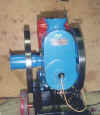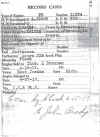 |
 |
 |
Fairmont started making engines as early as 1909. There were many models of engine manufactured but most of them can be divided into the following basic types - the plain bearing, (P series), the ball bearing (Q and OD series) and the roller bearing (R series). Here are some examples:
P Series: The PN model engine below (#11874) was manufactured in 1917 and shipped to a Thos. Brennan in East Jordan, Michigan. I don't yet know whether it was used in railroad service or as a stationary engine in an industrial environment. As one of the older series of engines, P's are now quite rare. Note that Fairmont could supply me with a build sheet for this 83 year old engine!!! This engine was sold in 2003 and is currently running in Missouri.
OD Series: The ODB model engine shown below was supplied as parts to a railroad in the Upper Peninsula of Michigan. It has never been used. I need to put the water hopper on and bolt the flywheels in place. You won't see too many ODB's around - by 1950 most railroads were specifying RO series engines in their motor cars instead of ODBs.
R Series: The R series are used in most cars from 1950 onwards. The three most common models are the ROB, ROC and RQ. Here are some photos of an ROB (#76602). This engine has an interesting history, being shipped from Fairmont, Minnesota to the New York, Chicago & St Louis Railroad Co (also known as the Nickel Plate Railroad) at Bellevue, Ohio. It came installed in an M19-E, arriving during September of 1946. It eventually was separated from the M19-E, either because it needed repair or maybe the car itself was worn out or severely damaged. The Nickel Plate was merged into the Norfolk & Western in 1964 and at some time after this date, the engine was sent to Princeton, West Virginia for rebuilding. Princeton was the location of the primary shops for the Virginian Railway, which had been merged into the Norfolk and Western Railway in 1959. The engine returned to Ohio but was never used again. In 1978, when motor car operations on the N&W were waning, management ordered that it be buried, along with an ROC engine and other Fairmont parts. Fortunately, the individual assigned to bury it took it home and put it in his barn, where it stayed for the next 22 years. I sold this engine to a speeder owner from Illinois in early 2001.
An uncommon model is the ROD. The engine block on an ROD is the same as that on an ODB, as is the throttle valve, flywheels and engine pulley. The piston and connecting rod are different only because of the smaller piston pins used before the larger size pins replaced them. The bearings and bearing housings are different, as one model had ball and one had roller bearings. The ROD came before the ROC and was an early attempt to have an air-cooled head in the RO series, reducing cost and complexity from that of the water-cooled head ROB configuration. This particular ROD was in an ex-Grand Trunk M19 built in 1944. Interesting fact - an ROD at a little better than half throttle gives 1900 rpm, which is 800 rpm at the rear axle.
The ROC was the ultimate development in the single cylinder RO series. It was still being sold by Fairmont in the early 1990's, a run of almost 50 years. ROCs were the most common engine that Fairmont built. Here are some photos of an ROC (#100386) that was rebuilt for me. It is now back into the ex-IC M9 shown elsewhere in this web site.
As well as being used in motor cars, these and other models of Fairmont engines can often be seen at antique engine shows around the country.
When your Fairmont Engine was Built
Manual Pages for these Engines
Last Edited 28 January, 2018